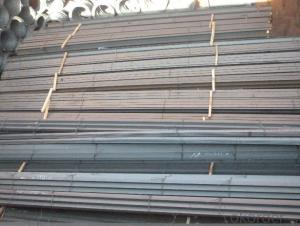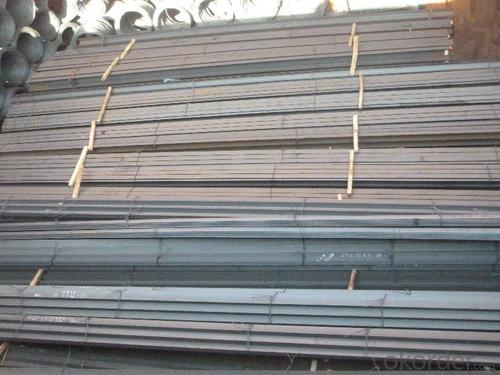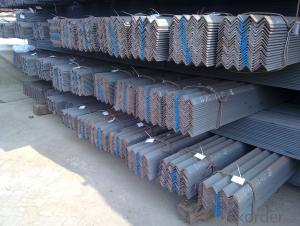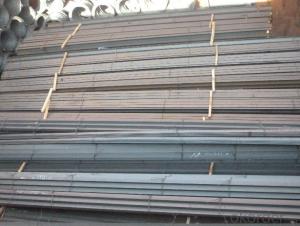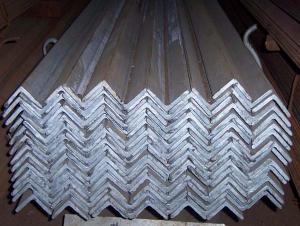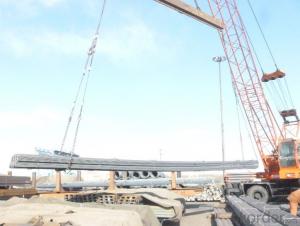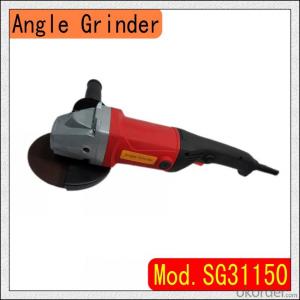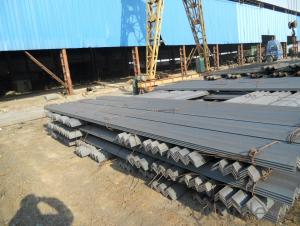angle
- Loading Port:
- China Main Port
- Payment Terms:
- TT OR LC
- Min Order Qty:
- -
- Supply Capability:
- -
OKorder Service Pledge
OKorder Financial Service
You Might Also Like
Product Description:
Specifications of Angle Steel
1. Invoicing on theoretical weight or actual weight as customer request
2. Length: 6m, 9m, 12m as following table
3. Sizes
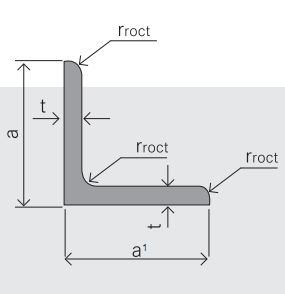
Sizes: 25mm-250mm | ||
a*t | ||
25*2.5-4.0 | 70*6.0-9.0 | 130*9.0-15 |
30*2.5-6.6 | 75*6.0-9.0 | 140*10-14 |
36*3.0-5.0 | 80*5.0-10 | 150*10-20 |
38*2.3-6.0 | 90*7.0-10 | 160*10-16 |
40*3.0-5.0 | 100*6.0-12 | 175*12-15 |
45*4.0-6.0 | 110*8.0-10 | 180*12-18 |
50*4.0-6.0 | 120*6.0-15 | 200*14-25 |
60*4.0-8.0 | 125*8.0-14 | 250*25 |
5. Payment terms:
1).100% irrevocable L/C at sight.
2).30% T/T prepaid and the balance against the copy of B/L.
3).30% T/T prepaid and the balance against L/C
6.Material details:
Alloy No | Grade | Element (%) | |||||
C | Mn | S | P | Si | |||
|
|
|
|
|
|
| |
Q235 | B | 0.12—0.20 | 0.3—0.7 | ≤0.045 | ≤0.045 | ≤0.3 | |
|
|
|
|
|
|
| |
Alloy No | Grade | Yielding strength point( Mpa) | |||||
Thickness (mm) | |||||||
≤16 | >16--40 | >40--60 | >60--100 | ||||
≥ | |||||||
|
|
|
|
|
| ||
Q235 | B | 235 | 225 | 215 | 205 | ||
Alloy No | Grade | Tensile strength (Mpa) | Elongation after fracture (%) | ||||
Thickness (mm) | |||||||
| ≤16 | >16--40 | >40--60 | >60--100 | |||
≥ | |||||||
|
|
|
|
|
|
| |
Q235 | B | 375--500 | 26 | 25 | 24 | 23 | |
Usage & Applications of Angle Steel
According to the needs of different structures, Angle can compose to different force support component, and also can be the connections between components. It is widely used in various building structures and engineering structures such as roof beams, bridges, transmission towers, hoisting machinery and transport machinery, ships, industrial furnaces, reaction tower, container frame and warehouse etc.
Packaging & Delivery of Angle Steel
1. Packing: it is nude packed in bundles by steel wire rod
2. Bundle weight: not more than 3.5MT for bulk vessel; less than 3 MT for container load
3. Marks:
Color marking: There will be color marking on both end of the bundle for the cargo delivered by bulk vessel. That makes it easily to distinguish at the destination port.
Tag mark: there will be tag mark tied up on the bundles. The information usually including supplier logo and name, product name, made in China, shipping marks and other information request by the customer.
If loading by container the marking is not needed, but we will prepare it as customer request.
Production flow of Angle Steel
Material prepare (billet) —heat up—rough rolling—precision rolling—cooling—packing—storage and transportation
- Q: How do you design connections for steel angles?
- When designing connections for steel angles, several factors need to be considered to ensure structural integrity and safety. Here are the key steps in designing connections for steel angles: 1. Determine the load and forces: Understand the loads the connection will be subjected to, such as tension, compression, or shear forces. Calculate the magnitude and direction of these forces to accurately assess the connection's requirements. 2. Select the type of connection: Determine the appropriate connection type based on the forces involved, structural design, and aesthetic requirements. Common connection types for steel angles include bolted, welded, or a combination of both. 3. Size the angles: Determine the appropriate size of the steel angles based on the loads and forces. Consider the angle's cross-sectional shape, material strength, and desired safety factors to ensure it can withstand the applied loads. 4. Check for interaction effects: Assess any interaction effects between the connection and the structural members. Account for any changes in the behavior of the angles due to the connection, such as added stiffness or reduction in capacity. 5. Design the connection details: Once the connection type and angle size are determined, design the connection details. Consider factors like the number and size of bolts, welding specifications, edge distances, and spacing requirements. 6. Check for failure modes: Analyze the connection design for potential failure modes, such as bearing, tearing, or shearing. Ensure that the connection has adequate strength and ductility to resist these failure modes. 7. Perform calculations and analysis: Utilize appropriate engineering principles and standards to perform calculations and analysis on the connection design. Check for factors like static equilibrium, stress distribution, and load transfer to confirm the connection's adequacy. 8. Incorporate design codes and standards: Adhere to relevant design codes and standards, such as the American Institute of Steel Construction (AISC) Manual, to ensure compliance with industry best practices and safety requirements. 9. Consider constructability and ease of fabrication: While designing connections, consider the constructability and ease of fabrication. Aim for simplicity in connection details to facilitate efficient manufacturing and construction processes. 10. Review and revise: Finally, review the connection design and seek input from structural engineers or other experts. Revise the design as necessary based on their recommendations to optimize the connection's performance and efficiency. By following these steps, engineers can design connections for steel angles that effectively transfer forces, ensure structural stability, and meet safety requirements.
- Q: Can steel angles be used for manufacturing balcony structures?
- Yes, steel angles can be used for manufacturing balcony structures. Steel angles are commonly used in construction due to their strength and durability. They provide structural support and stability, making them suitable for balcony structures. Steel angles are often used as support beams or framing components in balcony construction, providing a solid base for the balcony's flooring and railing. Additionally, steel angles can be easily fabricated and customized to meet specific design requirements, making them a versatile choice for balcony manufacturing.
- Q: What are the different methods of surface finishing for steel angles?
- Steel angles can be finished using various methods, each with its own advantages and considerations. Painting, galvanizing, powder coating, and shot blasting are the most commonly used methods. When it comes to surface finishing steel angles, painting is a popular choice. It not only protects against corrosion but also adds an appealing look. Typically, the angle is cleaned and primed before multiple coats of paint are applied. This method allows for a wide range of colors and easy touch-ups in case of damage. Galvanizing, on the other hand, involves coating the steel angle with zinc to safeguard it from corrosion. This method is particularly effective in harsh environments where moisture or chemicals may be present. The most common technique is hot-dip galvanizing, wherein the angle is immersed in molten zinc. This creates a durable finish that requires minimal maintenance. Another widely used method is powder coating, which entails applying a dry powder to the angle and then curing it with heat. This forms a protective layer that offers excellent durability and resistance to corrosion, chemicals, and UV rays. Powder coating also provides a smooth and consistent finish, with a wide array of color options. For a mechanical surface finishing approach, shot blasting is employed. This method involves blasting the steel angle with high-speed abrasive particles to remove rust, mill scale, or other contaminants. It results in a clean and smooth finish while creating a rough texture that enhances paint adhesion. Shot blasting is often used as a pre-treatment before painting or powder coating. When selecting a surface finishing method for steel angles, it is crucial to consider the specific requirements of their application. Factors such as the environment, expected lifespan, aesthetic preferences, and budget should all be taken into account. Seeking guidance from professionals or the steel manufacturer can help determine the most suitable surface finishing method for steel angles in a given situation.
- Q: Can steel angles be used in mezzanine or raised platform construction?
- Yes, steel angles can be used in mezzanine or raised platform construction. Steel angles are commonly used as structural supports in construction due to their strength and durability. They can be used as framing elements to create the framework of the mezzanine or raised platform. Steel angles provide stability and support to the structure, ensuring its robustness and ability to withstand heavy loads. Additionally, steel angles can be easily welded or bolted together, making them a versatile choice for construction projects.
- Q: Can steel angles be used as bracing elements?
- Yes, steel angles can be used as bracing elements. Steel angles are often used in construction as bracing elements due to their strength and stability. They can effectively provide support and enhance the structural integrity of a building or structure.
- Q: What are the properties of steel angles?
- Steel angles, which are also referred to as angle iron or L-shaped steel, possess numerous qualities that contribute to their extensive use and versatility across various industries. 1. Strength and durability: Solid steel is used to manufacture steel angles, resulting in exceptional strength and durability. These attributes render them suitable for structural applications that demand high strength, such as constructing building frames and supports. 2. Load-bearing capability: The L-shaped design of steel angles enables them to offer excellent load-bearing capacity. They can efficiently distribute weight and provide structural support, making them ideal for the construction of bridges, towers, and other heavy-duty structures. 3. Versatility in applications: The flexibility and adaptability of steel angles allow for their usage in a wide array of applications. They can be easily cut, drilled, and welded, facilitating customization to meet specific project requirements. Commonly employed in the construction, manufacturing, and automotive industries, steel angles showcase their versatility. 4. Resistance to corrosion: Steel angles can be manufactured with corrosion-resistant coatings or can be made from stainless steel. This provides protection against rust and other environmental factors. Thus, they are suitable for outdoor applications and environments with high moisture or chemical exposure. 5. Cost-effectiveness: Comparatively, steel angles are cost-effective when compared to other structural materials like aluminum or wood. They possess a high strength-to-weight ratio, thereby minimizing the amount of material required for a given application. Consequently, steel angles are a cost-efficient choice for various construction projects. 6. Aesthetic appeal: Steel angles can also be utilized for their aesthetic appeal, adding a visually pleasing dimension to architectural designs. They can serve decorative purposes in interior design or as part of ornamental structures, providing both functionality and visual interest. In conclusion, the properties of steel angles, including their strength, load-bearing capacity, versatility, corrosion resistance, cost-effectiveness, and aesthetic appeal, make them an excellent choice for a wide range of applications in different industries.
- Q: Can steel angles be used in HVAC ductwork?
- Yes, steel angles can be used in HVAC ductwork. Steel angles provide structural support and reinforcement to the ductwork, ensuring its stability and strength. They can be used to reinforce corners, joints, and connections, adding rigidity to the overall system. Steel angles are commonly used in commercial and industrial HVAC systems to enhance durability and longevity.
- Q: How are steel angles measured and specified?
- When it comes to steel angles, their dimensions and structural characteristics play a significant role in measurement and specification. The dimensions are determined by the length of the legs and the thickness of the material. The length of the legs refers to the vertical and horizontal sides of the angle, while the thickness represents the width. Expressing the dimensions of a steel angle can be done in two ways. One format is to state the length of the legs followed by the thickness, while the other format is to mention the thickness first and then the length of the legs. For example, an angle with legs measuring 2 inches and a thickness of 1/4 inch can be specified as 2" x 2" x 1/4" or 1/4" x 2" x 2". Apart from the dimensions, the structural characteristics of steel angles are also used for specification. This includes indicating the type of steel used, such as carbon steel or stainless steel, as well as mentioning the angle's load-bearing capacity and resistance to corrosion. Steel angles find extensive use in construction, manufacturing, and various industrial applications. They serve multiple purposes, such as providing structural support, acting as reinforcements, or serving as framing elements. By having a clear understanding of how steel angles are measured and specified, architects, engineers, and builders can effectively choose and utilize the appropriate angles for their projects.
- Q: What are the typical fabrication processes involved in manufacturing steel angles?
- Manufacturing steel angles involves a series of typical fabrication processes. These processes comprise cutting, bending, welding, and finishing. To begin the fabrication process, the steel is cut into the desired length or size. This can be accomplished using different methods such as sawing, shearing, or plasma cutting. Following the cutting stage, the steel angle might require bending to achieve the desired shape. Bending can be performed using a press brake or a rolling machine. This process is crucial as it helps create the necessary angle and ensures the steel possesses the required strength and stability. Once the steel angle has been cut and bent, it may need to undergo welding in order to join the various pieces together. Welding is a critical process that guarantees the strength and integrity of the steel angle. It involves heating the steel to its melting point and fusing the pieces together using a filler material. Finally, the steel angle undergoes a finishing process. This typically involves surface cleaning, grinding, or polishing to eliminate any imperfections or rough edges. The finishing process serves to enhance the appearance of the steel angle and improve its resistance to corrosion. Overall, cutting, bending, welding, and finishing are the essential fabrication processes involved in manufacturing steel angles. These processes are indispensable in creating steel angles that meet specific design requirements and quality standards.
- Q: Can steel angles be used for load-bearing walls?
- No, steel angles are not typically used for load-bearing walls. Load-bearing walls require structural support and are typically constructed using materials such as reinforced concrete or steel beams/columns. Steel angles may be used for non-load-bearing purposes such as framing or decorative purposes.
Send your message to us
angle
- Loading Port:
- China Main Port
- Payment Terms:
- TT OR LC
- Min Order Qty:
- -
- Supply Capability:
- -
OKorder Service Pledge
OKorder Financial Service
Similar products
Hot products
Hot Searches
Related keywords
